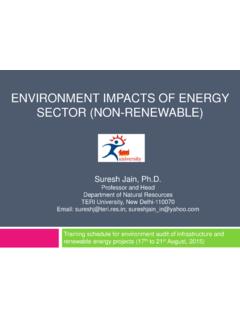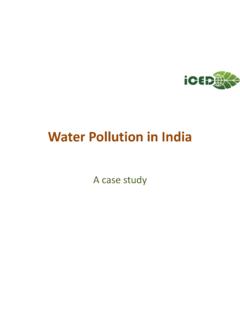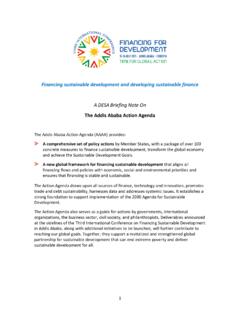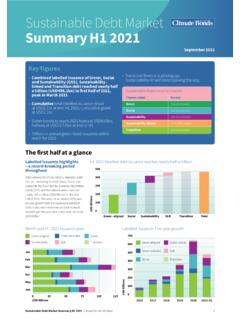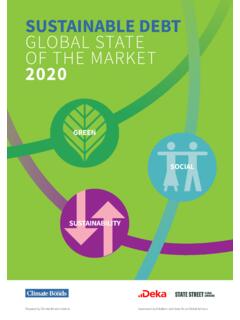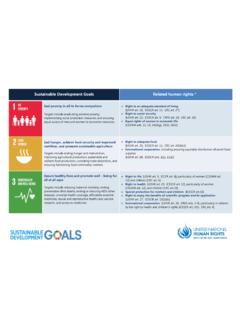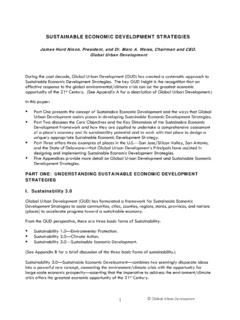Transcription of Sustainable Development: An Introduction
1 Sustainable Development: An IntroductionNinikaDhawan& RumbidzaiFaith MasawiEmail: Fellow, The Energy and Resources Institute (TERI)23 March 2015 International Centre for Environment Audit and Sustainable Development (iCED)JaipurQUESTIONWhat do you understand by Sustainable development? Why are we understanding this concept?Nation s Conscience KeeperStructurePart I: Theoretical understanding of Sustainable development and related conceptsActivityPart II: Case study: Sustainable mega events in developing countries PART I: Sustainable DEVELOPMENT: CONCEPTS AND EVOLUTIONS ustainable Development: Global GenesisDEFINITIONS ustainable development is development that meets the needs of the present without compromising the ability of future generations to meet their own needs.
2 It contains within it two key concepts: the concept of 'needs', in particular the essential needs of the world's poor, to which overriding priority should be given; and the idea oflimitationsimposed by the state of technology and social organization on the environment's ability to meet present and future needs.(Chapter 2, Our Common Future: Report of the World Commission on Environment and Development, 1987) Constitutional Framework Article 19(a), Noise pollution; Article 21 conferring the Right to Life encompasses right to clean environment, right to livelihood, right to live with dignity and a number of other associated rights Article 47-nutrition, standard of living and public health Article 48 (A)-to protect and improve the environment and to safeguard the forests and wild life of the country Article 51-A (g)-duty of every citizen to protect and improve the natural environment including forests, lakes, rivers and wild life and to have compassion for living creaturesIndian ContextThe National Environment Policy 2006 Seventh Five Year Plan (1985-1990)
3 Only such development is Sustainable , which respects ecological constraints and the imperatives of social justice environment includes water, air and land and the interrelationship which exists among and between air, water and land and human beings, other living creatures, plants, micro-organism and property . If the gains in productivity are to be sustained, resources must also continue to be available over time. This requires that, while providing for current needs, the resources base be managed so as to enable Sustainable development. (Volume 2, Chapter 18) Introduced before the UNCED, 1992 For developing countries Sustainable development will be linked to social pillar and inclusivityEnvironment (Protection) Act, 1986 Components of Sustainable Development: Dominant View Three pillars of Sustainable development Economic Social Environmental Achievements policy mainstreaming and consensus building Responsible corporate conduct Formal and informal institutions working together Criticisms Compartmentalized Leading to Isolated actions?
4 An oxymoron, fuzzy?EconomicSocialEnvironmentalSustain able developmentInspired by Our Common Future, 1987;World Summit, 2005 Figure Three pillars of Sustainable developmentGovernanceComponents of Sustainable Development: Emerging ViewFocus also on interfaces: Social ecology Green economy Social equitySocialEnvironmentSocial EcologySustainable DevelopmentGreen EconomySocial EquityEconomySocialEnvironmentSocial EcologySustainable DevelopmentGreen EconomySocial EquityEconomyGoI(2010), official submission to UNCSD second preparatory committee meeting, pg 30 Figure Interfaces of the components of Sustainable developmentInstitutionsInstitutions and stakeholders Major Groups Governments International communitySource.
5 MoEF-TERI (2011)Multiple drivers and discussion around SD Global environment issues Climate change Biodiversity loss Land degradation Traditional security Conflicts and wars Non-traditional security Energy Food Water Others Global integration Inequity intra-generational inequity Inter-generational inequity Inter-regional inequity Inter-species equity Financial crisesZimbabwe2014 Sustainable DevelopmentA timelineNagoya Protocol2014 Key principles Rio principles (27; International policy) Agenda 21 and JPOI The precautionary principle (General)-ESZ United Nations Global Compact (Corporate) The triple bottom line-people, planet, profit or the three pillars (Corporate) The Equator Principles (EPs) (Banking) EU Eco-Management and Audit Scheme (EMAS)Global Policy: Some developments The United Nations Open Working Group has proposed seventeen Sustainable Development Goals (SDGs) in the 68thSession of the General Assembly in 2014.
6 SDGs are supposed to be action oriented, globalin nature and universally applicable to all countries, while taking into account different national realities, capacities and levels of development and respecting national policies and priorities. Policy: Some developmentsProposed Sustainable Development Goals by the UN Open Working nameGoal 1 End povertyin all its forms everywhereGoal 2 End hunger, achieve food securityand improved nutritionand promote Sustainable agricultureGoal 3 Ensure healthy lives and promote well-being for all at all agesGoal 4 Ensure inclusive and equitable quality educationand promote lifelong learning opportunities for allGoal 5 Achieve gender equality and empower all women and girlsGoal 6 Ensure availability and Sustainable management of water and sanitation for allGoal 7 Ensure access to affordable, reliable, Sustainable and modern energy for allGoal 8 Promote sustained.
7 Inclusive and Sustainable economic growth, full and productive employmentand decent work for allGoal 9 Build resilient infrastructure, promote inclusive and Sustainable industrialization and foster innovationGoal 10 Reduce inequality within and among countriesGoal 11 Make cities and human settlements inclusive, safe, resilient and sustainableGoal 12 Ensure Sustainable consumption and production patternsGoal 13 Take urgent action to combat climate change and its impactsGoal 14 Conserve and sustainably use the oceans, seas andmarine resourcesfor Sustainable developmentGoal 15 Protect, restore and promote Sustainable use of terrestrial ecosystems, sustainably manage forests, combat desertification, and halt and reverse land degradation and halt biodiversity lossGoal 16 Promote peaceful and inclusive societies for Sustainable development, provide access to justice for all and build effective, accountable and inclusive institutions at all levelsGoal 17 Strengthen the means of implementation and revitalize the global partnership for Sustainable developmentSome Indicators on Sustainable Development Social Economic Environmental InstitutionalSource.
8 UNThemeSub-themeIndicatorEquityHeadcount RatioPovertyGiniindex of income inequalityUnemployment rateMultidimensional Poverty IndexGender equalityGender Inequality IndexNutritional statusNutritional status of childrenMortalityMortality rate under 5 years oldInfantmortalityrateLife expectancy at birthHealthSanitationPercent of population with adequate sewage disposal facilitiesDrinking waterPopulation with access to safe drinking waterPercent of population with access to primary health care facilitiesHealthcare deliveryImmunization against infectious childhood diseasesContraceptive prevalence rateEducationEducation levelChildren reaching grade 5 of primary educationAdult secondary education achievement levelSocialThemeSub-themeIndicatorEconom icstructureEconomic performanceGDP per capitaInvestment share in GDPT radeBalance of trade in goods and servicesFinancial statusDebt to GDP ratioTotal ODA given or received as a percent of GNPF iscalDeficitConsumptionand productionpatternsMaterial consumptionIntensity of material useAnnual energy consumption per capitaShare of consumption of renewable energy resourcesEnergy useEnergy use per unit, by sectorIntensity of energy use.
9 TransportationEnergyImportsEconomicTheme Sub-themeIndicatorAtmosphereClimate changeEmissions of greenhouse gasesOzone layer depletionConsumption of ozone depleting substancesAir qualityAmbient concentration of air pollutants in urban areasLandAgricultureArable and permanent crop land areaPer hectare food grain productionPercentage of gross cropped area irrigatedUse of fertilizersEnvironmentalThemeSub-themeIn dicatorInstitutionalframeworkStrategic implementation of SDNational Sustainable development strategyInternational cooperationImplementation of ratified global agreementsInstitutionalcapacityScience and technologyExpenditure on research and developmentDisaster preparedness and responseEconomic and human loss due to natural disastersCommunication InfrastructureMain telephone lines per 1000 inhabitantsInformation AccessNumber of internet subscribers per 1000 inhabitantsInstitutionalEco-Management and Audit Scheme (EMAS)EnvironmentalKey AreaInput/ImpactEnergy EfficiencyTotal direct energy useTotal annual energy consumption (MWH)Renewable Energy UseMaterial EfficiencyAnnual mass flow of different materials (energy carriers andwater)WaterAnnualconsumption WasteAnnualgeneration of waste (tonnes), hazardous wasteBiodiversityUse of landEmissionsTotal annual emission of GHG (Co2, N2O,HFC, PFC, SF6)
10 In tonnesof CO2 equivalentTotal annual air emission Sustainable Development-IssuesThe Future We WantMAKE IN INDIAENERGY SECURITYSMART CITIESSWACHHBHARATPART II: CASE STUDYP roject on mega-events and Sustainable development in developing countries Project conducted by TERI in partnership with SEA (South Africa) and GiTEC(Brazil); supported by KonradAdenaurStiftung(KAS) Common framework by three partner research organization Broad framework(SD) Economic (including fiscal) Social Environmental InstitutionalIntroduction Hosting of mega-events has a tremendous effect on developing and emerging countries. Positive -economic investment, job creation, skills development and international branding Negative -environmental footprint, for example via carbon emissionsMust How such a mega-event, in particular the expenditure and investments that come with it, will benefit the poor.


